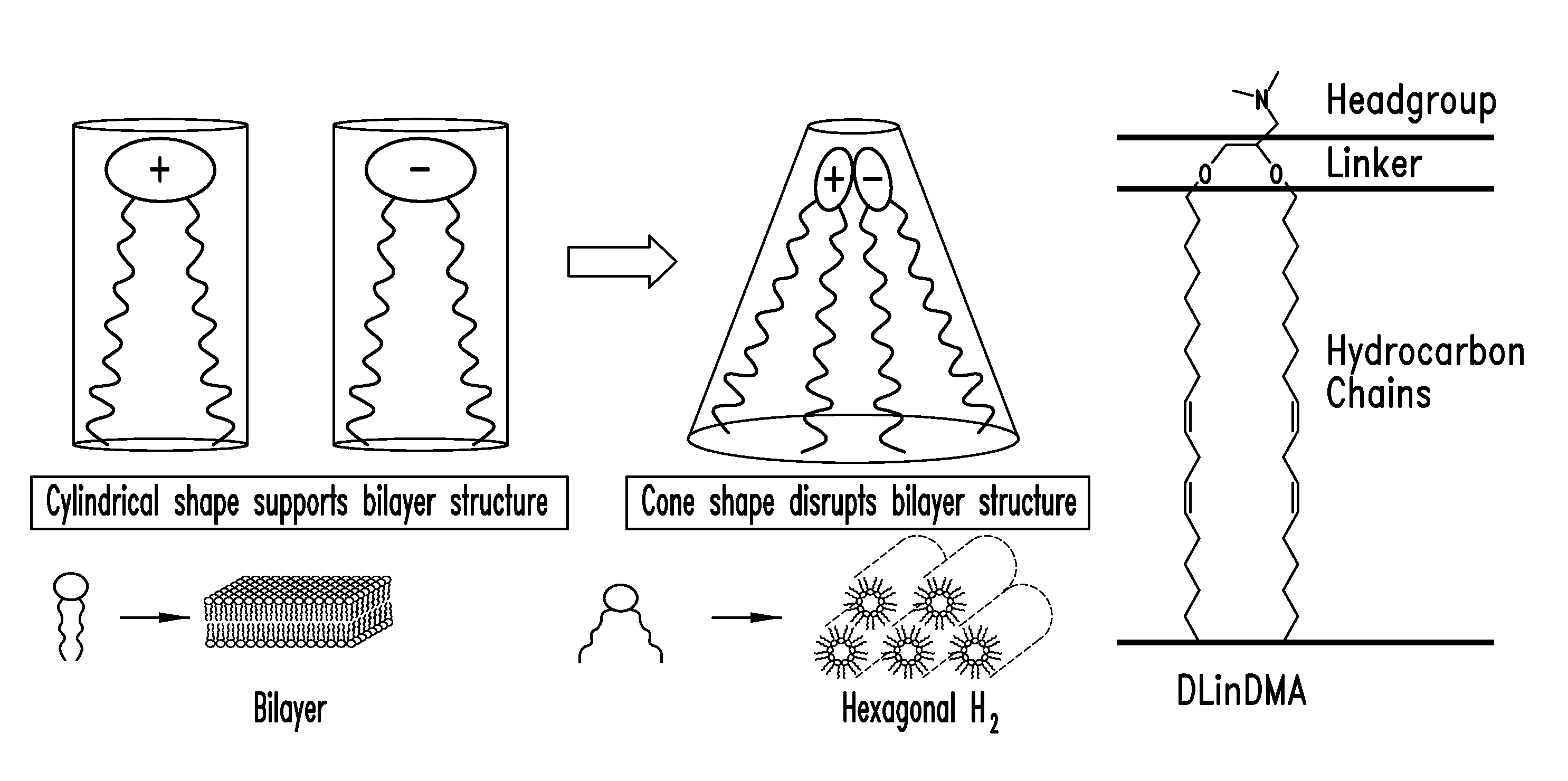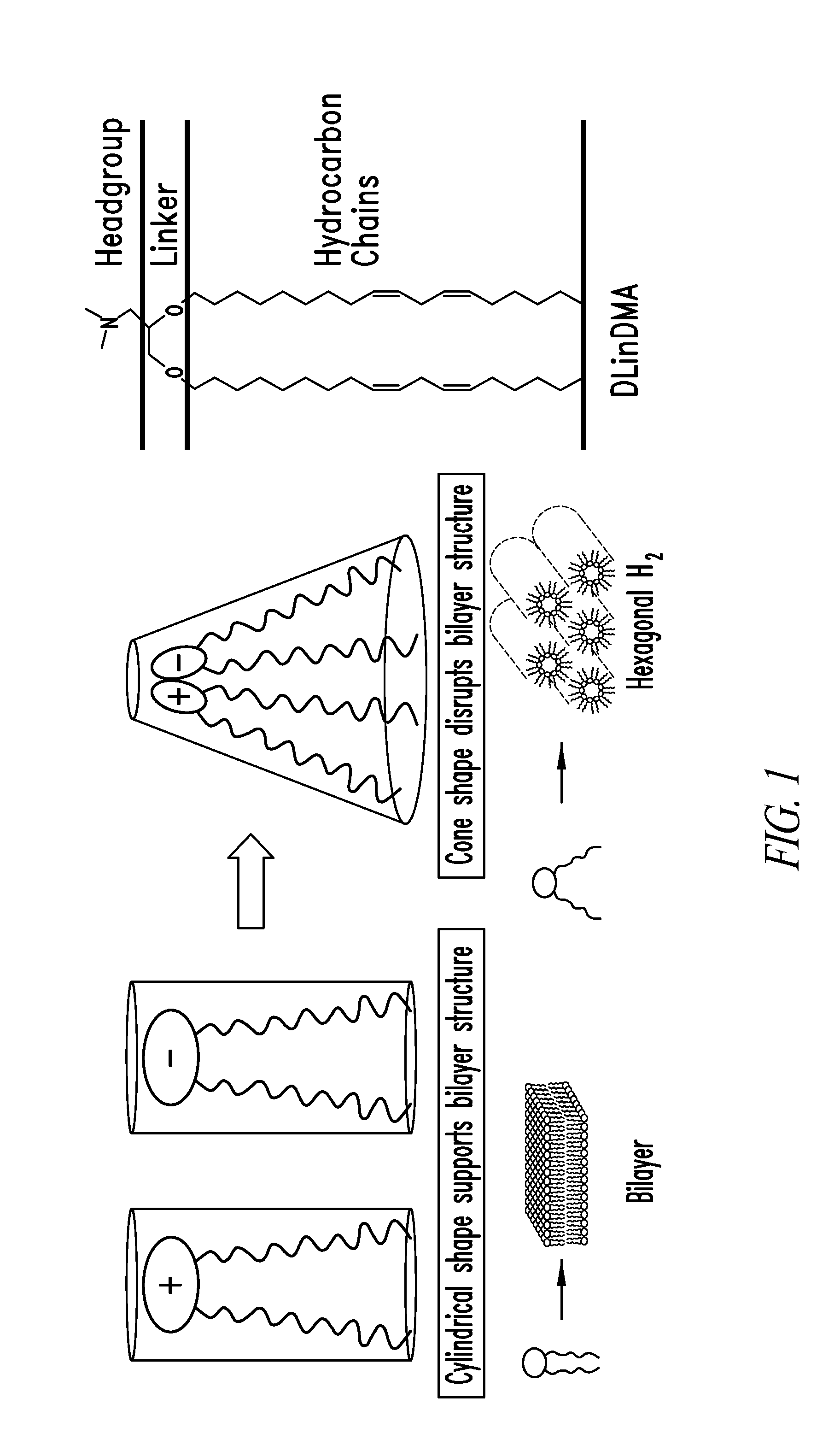Amino lipids and methods for the delivery of nucleic acids
a technology of amino lipids and nucleic acids, which is applied in the direction of drug compositions, tissue culture, immunological disorders, etc., can solve the problems of limited ability to gain access to the intracellular compartment, decrease the activity of the construct, and the susceptibility of plasma nucleases, so as to increase the expression of the polypeptide or the functional variant or fragment thereo
- Summary
- Abstract
- Description
- Claims
- Application Information
AI Technical Summary
Benefits of technology
Problems solved by technology
Method used
Image
Examples
example 1
Synthesis of 2,2-Dilinoleyl-4-Dimethylaminomethyl-[1,3]-Dioxolane (DLin-K-DMA)
[0256]DLin-K-DMA was synthesized as shown in the following schematic and described below.
Synthesis of Linoleyl Bromide (II)
[0257]A mixture of linoleyl methane sulfonate (6.2 g, 18 mmol) and magnesium bromide etherate (17 g, 55 mmol) in anhydrous ether (300 mL) was stirred under argon overnight (21 hours). The resulting suspension was poured into 300 mL of chilled water. Upon shaking, the organic phase was separated. The aqueous phase was extracted with ether (2×150 mL). The combined ether phase was washed with water (2×150 mL), brine (150 mL), and dried over anhydrous Na2SO4. The solvent was evaporated to afford 6.5 g of colourless oil. The crude product was purified by column chromatography on silica gel (230-400 mesh, 300 mL) and eluted with hexanes. This gave 6.2 g (approximately 100%) of linoleyl bromide (II). 1H NMR (400 MHz, CDCl3) δ: 5.27-5.45 (4H, m, 2×CH═CH), 3.42 (2H, t, CH2Br), 2.79 (2H, t, C═C—...
example 2
Synthesis of 1,2-Dilinoleyloxy-N,N-Dimethyl-3-Aminopropane (DLinDMA) DLinDMA was Synthesized as Described Below
[0263]
[0264]To a suspension of NaH (95%, 5.2 g, 0.206 mol) in 120 mL of anhydrous benzene was added dropwise N,N-dimethyl-3-aminopropane-1,2-diol (2.8 g, 0.0235 mol) in 40 mL of anhydrous benzene under argon. Upon addition, the resulting mixture was stirred at room temperature for 15 min. Linoleyl methane sulfonate (99%, 20 g, 0.058 mol) in 75 mL of anhydrous benzene was added dropwise at room temperature under argon to the above mixture. After stirred at room temperature for 30 min., the mixture was refluxed overnight under argon. Upon cooling, the resulting suspension was treated dropwise with 250 mL of 1:1 (V:V) ethanol-benzene solution. The organic phase was washed with water (150 mL), brine (2×200 mL), and dried over anhydrous sodium sulfate. Solvent was evaporated in vacuo to afford 17.9 g of light oil as a crude product. 10.4 g of pure DLinDMA were obtained upon puri...
example 3
Synthesis of 2,2-Dilinoleyl-4-(2-Dimethylaminoethyl)[1,3]-Dioxolane (DLin-K-C2-DMA)
[0265]DLin-K-C2-DMA was synthesized as shown in the schematic diagram and description below.
Synthesis of 2,2-Dilinoleyl-4-(2-hydroxyethyl)-[1,3]-dioxolane (II)
[0266]A mixture of dilinoleyl ketone (I, previously prepared as described in Example 1, 527 mg, 1.0 mmol), 1,3,4-butanetriol (technical grade, ca. 90%, 236 mg, 2 mmol) and pyridinium p-toluenesulfonate (50 mg, 0.2 mmol) in 50 mL of toluene was refluxed under nitrogen overnight with a Dean-Stark tube to remove water. The resulting mixture was cooled to room temperature. The organic phase was washed with water (2×30 mL), brine (50 mL), and dried over anhydrous Na2SO4. Evaporation of the solvent resulted in a yellowish oily residual (0.6 g). The crude product was purified by column chromatography on silica gel (230-400 mesh, 100 mL) with dichloromethane as eluent. This afforded 0.5 g of pure II as colourless oil. 1H NMR (400 MHz, CDCl3) δ: 5.25-5.4...
PUM
| Property | Measurement | Unit |
|---|---|---|
| pH | aaaaa | aaaaa |
| pKa | aaaaa | aaaaa |
| diameter | aaaaa | aaaaa |
Abstract
Description
Claims
Application Information
 Login to View More
Login to View More - R&D
- Intellectual Property
- Life Sciences
- Materials
- Tech Scout
- Unparalleled Data Quality
- Higher Quality Content
- 60% Fewer Hallucinations
Browse by: Latest US Patents, China's latest patents, Technical Efficacy Thesaurus, Application Domain, Technology Topic, Popular Technical Reports.
© 2025 PatSnap. All rights reserved.Legal|Privacy policy|Modern Slavery Act Transparency Statement|Sitemap|About US| Contact US: help@patsnap.com



